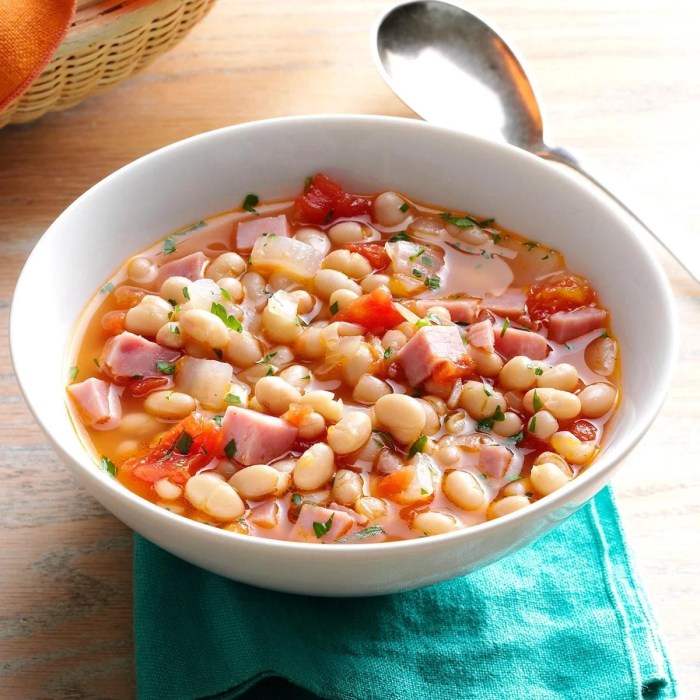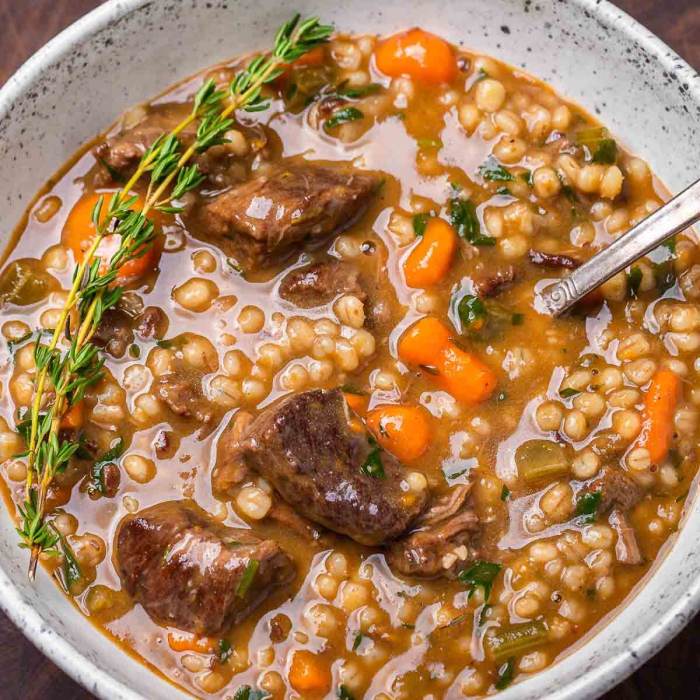Beef and Bean Soup: A Culinary Exploration: Beef And Bean Soup Recipe

Source: tmbi.com
Beef and bean soup recipe – Beef and bean soup, a hearty and comforting classic, offers a world of culinary possibilities. This exploration delves into recipe variations, ingredient considerations, cooking techniques, and serving suggestions to elevate your beef and bean soup experience.
Recipe Variations, Beef and bean soup recipe

Source: sipandfeast.com
The beauty of beef and bean soup lies in its adaptability. Three variations, each featuring a different bean, showcase the versatility of this dish. We will also explore slow cooker and pressure cooker methods, and the impact of different beef cuts.
Kidney Bean Beef Stew (Slow Cooker): This recipe utilizes a slow cooker for tender beef and deeply flavorful broth. The kidney beans contribute a rich, earthy note. The slow cooking process allows the flavors to meld beautifully.
Pinto Bean Beef Soup (Pressure Cooker): The pressure cooker significantly reduces cooking time, resulting in a quick and flavorful soup. Pinto beans add a creamy texture and mild, subtly sweet flavor. The high pressure ensures tender beef in a fraction of the time.
Black Bean Beef and Corn Chowder (Stovetop): This variation incorporates black beans for a smoky, slightly sweet flavor profile, alongside sweet corn for added texture and sweetness. This recipe is ideal for a quicker stovetop preparation.
Beef Cut Comparison: Using chuck roast yields a tender, flavorful soup after a long simmer. Short ribs, while more expensive, provide incredibly rich flavor and melt-in-your-mouth tenderness. A less expensive option like stew beef will also work, but may require longer cooking times for optimal tenderness.
Ingredient Exploration
The nutritional value and flavor profiles of the ingredients significantly impact the final product. Understanding these aspects enhances the overall culinary experience.
Nutritional Benefits of Beans: Beans are excellent sources of fiber, protein, and various vitamins and minerals. Kidney beans are rich in iron, while pinto beans are a good source of folate. Black beans are packed with antioxidants. The specific nutritional profile varies slightly depending on the bean type.
Best Beef Cuts: Chuck roast, short ribs, and stew beef are all excellent choices for beef and bean soup. Chuck roast provides a good balance of flavor and tenderness after slow cooking. Short ribs offer intense flavor and melt-in-your-mouth texture. Stew beef is a more economical option that requires longer cooking times.
Herbs and Spices: A blend of herbs and spices elevates the flavor profile. Cumin, chili powder, oregano, and bay leaves are common additions. For a smoky flavor, chipotle peppers in adobo sauce can be incorporated. A hint of thyme or rosemary adds an earthy complexity.
| Bean Type | Cooking Time (approx.) | Texture | Flavor Profile |
|---|---|---|---|
| Kidney Beans | 1-2 hours (depending on method) | Firm but tender | Earthy, slightly sweet |
| Pinto Beans | 1-1.5 hours (depending on method) | Creamy | Mild, subtly sweet |
| Black Beans | 45-60 minutes (depending on method) | Firm | Smoky, slightly sweet |
Cooking Techniques and Methods
Proper preparation and cooking techniques are crucial for achieving a flavorful and tender soup. This section Artikels the steps involved in preparing the beef and beans, and different methods for thickening the soup.
Beef Preparation: Browning the beef before adding it to the soup develops a rich, deep flavor. Simmering the beef in liquid until tender is essential for a palatable result. The simmering time will vary depending on the cut of beef used.
Bean Cooking: Soaking dried beans overnight significantly reduces cooking time and improves texture. Proper cooking ensures tender beans without mushiness. Pressure cooking or slow cooking are efficient methods for cooking beans.
Step-by-Step Guide: (A detailed step-by-step guide with timings and temperatures would be included here, tailored to a specific recipe. This would be a multi-paragraph section with precise instructions).
Thickening Methods: A roux (a mixture of butter and flour) creates a smooth, creamy consistency. A cornstarch slurry (cornstarch mixed with cold water) is another option for thickening, offering a slightly less rich texture. Both methods require careful addition to prevent lumps.
Serving Suggestions and Enhancements
Serving suggestions and garnishes enhance the overall presentation and flavor profile of the soup. The following are some ideas to elevate your beef and bean soup.
Serving Suggestions: Serve with crusty bread for dipping, alongside a side salad for a refreshing contrast, or as part of a hearty chili bar with various toppings.
Garnishes: Fresh cilantro, a dollop of sour cream or Greek yogurt, a sprinkle of shredded cheese, or a drizzle of olive oil all add visual appeal and enhance the flavor.
- Chopped green onions
- Sliced avocado
- Lime wedges
- Shredded Monterey Jack cheese
- Pickled jalapeños
Crusty Bread Recipe: (A detailed recipe for a crusty bread, including instructions and a description of the desired texture and flavor, would be included here. This would be a multi-paragraph section with precise instructions).
Visual Representation
The visual appeal of the soup is an important aspect of the overall dining experience. The color, consistency, and appearance of the ingredients contribute to this.
Ideal Color and Consistency: A well-made beef and bean soup has a rich, deep brown color from the beef broth and browned beef. The consistency should be thick but not overly so, allowing for easy spooning. The beans should be tender but not mushy.
A hearty beef and bean soup is a comforting classic, perfect for a chilly evening. For a lighter, yet equally satisfying option, consider a vibrant alternative like the tomato veg soup recipe ; its bright flavors offer a nice contrast. Returning to our beef and bean soup, remember to simmer it long and low for maximum flavor development.
Appearance of Ingredients: The beef should be tender and easily shredded, with a dark brown color. The beans should be plump and well-cooked, with their natural color retained. The overall appearance should be inviting and appetizing.
Stages of Cooking: Initially, the beef will be a raw red color. After browning, it will be dark brown. As it simmers, the liquid will darken and the beef will become more tender. The beans will start firm and gradually soften as they cook.
Clarifying Questions
Can I use canned beans instead of dried?
Yes, canned beans are a convenient alternative. Just be sure to rinse them well before adding them to the soup to remove excess sodium.
How long can I store leftover beef and bean soup?
Leftover soup can be stored in an airtight container in the refrigerator for up to 3-4 days.
Can I freeze beef and bean soup?
Yes, beef and bean soup freezes well. Allow it to cool completely before storing it in freezer-safe containers for up to 2-3 months.
What if my soup is too thin?
You can thicken the soup by simmering it uncovered for a longer period to reduce the liquid. Alternatively, you can make a cornstarch slurry (mix cornstarch with cold water) and stir it into the soup.
